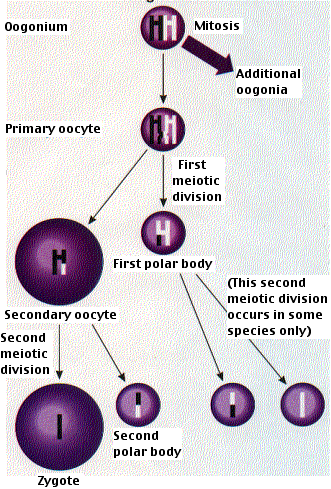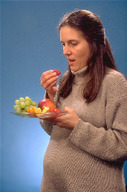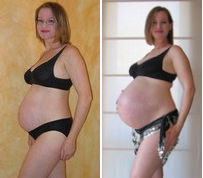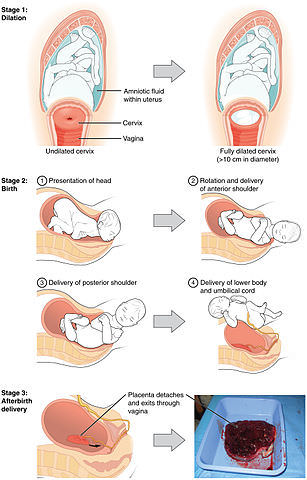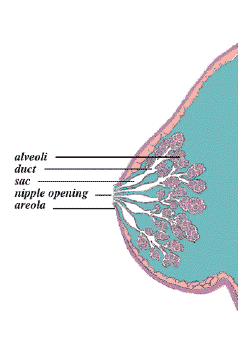妇女生殖系统的职能
章节大纲
-
Waiting Expectantly
::期待等待A mother-to-be waits patiently for her fetus to grow as her belly gradually swells. is all about making babies, and the female reproductive system is specialized for this purpose. Its functions include producing female gametes called eggs , secreting female sex hormones (such as estrogen), providing a site for , gestating a fetus if fertilization occurs, giving birth to a baby, and breastfeeding a baby after birth. The only thing missing is .
::母亲将耐心等待胎儿随着肚子逐渐膨胀而成长。 这一切都是为了生孩子,而女性生殖系统是专门为此而建立的。 它的职能包括生产被称为鸡蛋的女调子,秘密雌性激素(如雌激素),提供一个场所,供胎儿受精、生孩子和婴儿哺乳时使用。 唯一缺少的是。Egg Production
::鸡蛋生产At birth, a female’s ovaries contain all the eggs she will ever produce, which may include a million or more eggs. T he eggs don't start to mature, however, until she enters and attains sexual maturity. After that, one egg typically matures each month, and is released from an ovary. This continues until a woman reaches menopause (cessation of monthly periods), typically by age 52. By then, viable eggs may be almost depleted, and levels can no longer support the monthly cycle. During the reproductive years, which of the two ovaries releases an egg in a given month seems to be a matter of chance. Occasionally, both ovaries will release an egg at the same time. If both eggs are fertilized, the offspring are fraternal twins (dizygotic, or "two- zygote ," twins), and they are no more alike genetically than non-twin siblings.
::产卵时,雌性卵巢中包含所有产卵,其中可能包括一百万个或更多个蛋。但卵子不会开始成熟,直到她进入并达到性成熟程度。此后,每个月有一个蛋通常成熟,从卵子中释放出来。这一直持续到女性更年期(每月停产期),通常到52岁。 到那时,可行的卵子可能几乎耗尽,并且水平无法再维持月周期。 在育龄期,两个卵子中的卵子在某个月释放一个蛋似乎是一个偶然问题。 偶尔,两个卵子都会同时释放一个蛋。 如果两个卵子都受精,后代都是兄弟双胞胎(双胞胎或双胞胎 ) , 它们没有比非双胞胎兄弟更相似的基因。Oogenesis
::来源来源The process of producing eggs in the ovaries of a female fetus is called oogenesis . Eggs are haploid gametes, and their production occurs in several steps that involve different types of , as summarized in the figure . Oogenesis is completed long before birth. It occurs when diploid germ cells called oogonia (singular, oogonium) undergo . Each such produces two diploid daughter cells . One is called the primary oocyte , and the other is retained to help maintain a reserve of oogonia. The primary oocyte, in turn, starts to go through the division of (meiosis I). However, it does not complete meiosis I until much later. Instead, it remains in a resting state, nestled within a tiny, immature follicle in the ovary until the female goes through puberty.
::雌性胎儿卵巢中产卵的过程被称为卵的产卵过程。卵子是杂乱的组合体,其产卵过程分为几步,涉及不同类型,如图中所概括的那样。 产卵过程在出生前很早就完成。 产卵过程在出生前很久就已完成。 产卵过程在被叫做ooogonia( singal, oogonium)的浸泡性细菌细胞中发生。 两种产卵细胞都产卵两个。 一种被称为主要卵细胞, 另一种保留用于帮助维持卵子的储备。 主要的卵细胞, 反过来, 开始通过( meiiscision I) 的分裂过程。 但是, 它直到很久以后才完全完成甲状腺病 I 。 相反, 它仍然处于休眠状态, 扎在卵巢中的小不成熟的卵囊中,直到雌性进入青春期。Formation of a secondary oocyte that may become a zygote begins with mitosis of an oogonium. This is followed by two meiotic cell divisions. In humans, the first polar body does not undergo the second meiotic division illustrated here.
::二次卵细胞形成后, 可能成为zygote 的子细胞会开始于 ogonium 的分裂。 之后是两个微量细胞分裂。 在人类中, 第一个极体不会经历这里所展示的第二个微量分裂 。Maturation of a Follicle
::熔冰的成熟期Beginning in puberty, about once a month, one of the follicles in an ovary undergoes maturation, and an egg is released. As the follicle matures, it goes through changes in the numbers and types of its cells. The primary oocyte within the follicle also resumes meiosis. It completes meiosis I, which began long before birth, to form a secondary oocyte and a smaller cell, called the first polar body . Both the secondary oocyte and the first polar body are haploid cells. The secondary oocyte has most of the cytoplasm from the primary oocyte and is much larger than the first polar body, which soon disintegrates and disappears. The secondary oocyte begins meiosis II, but only completes it if the egg is fertilized.
::从青春期开始,大约每个月一次,卵巢中的卵囊之一开始成熟,并且释放出一个蛋。当卵囊成熟时,它经历了细胞数量和种类的变化。在卵囊内的主要卵细胞细胞也恢复了 meisis。它完成在出生前很久开始的甲状腺化I,形成一个二级卵细胞,一个较小的细胞,称为第一个极体。二级卵细胞和第一个极体都是手动细胞。二级卵细胞大部分是原卵细胞的细胞,比第一个极体大得多,而第一个极体很快会分解并消失。二级卵细胞开始细胞化II,但只有在卵发酵时才能完成。Release of an Egg
::卵蛋释放It typically takes 12 to 14 days for a follicle to mature in an ovary, and for the secondary oocyte to form. Then, the follicle bursts open and the ovary ruptures, releasing the secondary oocyte from the ovary. This event is called ovulation . The now-empty follicle starts to change into a structure called a corpus luteum . The expelled secondary oocyte is usually swept into the nearby Fallopian tube by its waving, fringelike fimbriae.
::通常需要12到14天才能在卵巢中发育,再生卵细胞则需要12到14天才能形成。然后,卵囊爆发,卵巢破裂,从卵巢中释放第二卵细胞。这个事件被称为排卵。现在空的卵囊开始变成一个结构,叫做体。被排出的二级卵细胞通常通过挥舞,如边缘的纤维膜,被冲入附近的Fallopian管。Uterine Changes
::子值变化While the follicle is maturing in the ovary, the uterus is also undergoing changes to prepare it for an embryo if fertilization occurs. For example, the endometrium gets thicker and becomes more vascular. Around the time of ovulation, the cervix undergoes changes that help sperm reach the oocyte to fertilize it. The cervical canal widens, and cervical mucus becomes thinner and more alkaline. These changes help promote the passage of sperm from the vagina into the uterus and make the environment more hospitable to sperm.
::当卵巢中的卵泡成熟时,子宫也正在发生变化,以备胚胎受精。例如,子宫内子宫变厚,血管变大。在卵巢期间,子宫内子宫会发生改变,帮助精子到达卵细胞,使其受精。宫颈运河扩大,宫颈肌肉变薄,碱性增加。这些变化有助于促使精子从阴道进入子宫,使环境更适合精子生长。Fertilization — or Not
::肥化——或不肥化Fertilization of an egg by a sperm normally occurs in a Fallopian tube, most often in the part of the tube that passes above the ovary (see figure ). In order for fertilization to occur, sperm must “swim” from the vagina where they are deposited, through the cervical canal to the uterus, and then through the body of the uterus to one of the Fallopian tubes. Once sperm enter a Fallopian tube, tubular fluids help carry them through the tube toward the secondary oocyte at the other end. The secondary oocyte also functions to promote fertilization. It releases molecules that guide the sperm and allow the surface of the egg to attach to the surface of the sperm. The egg can then absorb the sperm, allowing fertilization to occur.
::精子的精子受精通常在输卵管中发生,通常在输卵管上方的输卵管中发生(见图 ) 。 为了进行授精,精子必须从其沉积的阴道、通过宫颈运河向子宫内循环,然后通过子宫身体向输卵管之一循环。一旦精子进入输卵管,管状液将精液通过管将精子通过输卵管向另一端的二级卵细胞。二级卵细胞也起到促进授精的作用。它释放出指导精子的分子,并允许卵的表面附在精子表面。然后,卵可以吸收精子,并允许施肥。This diagram shows the structures through which sperm must pass if fertilization of an egg is to occur. It also shows the event of fertilization, and where fertilization usually occurs.
::该图显示蛋的受精过程必须经过的精子结构,还显示受精过程的发生,以及施精过程的通常发生地点。If Fertilization Occurs
::如果化肥化有机物If the secondary oocyte is fertilized by a sperm as it passes through the Fallopian tube, the secondary oocyte quickly completes meiosis II, forming a diploid zygote and another polar body. (This second polar body, like the first, normally breaks down and disappears.) The zygote then continues the journey through the Fallopian tube to the uterus, during which it undergoes several mitotic cell divisions. By the time it reaches the uterus up to five days after fertilization, it consists of a ball of cells called a blastocyst . Within another day or two, the blastocyst implants itself in the endometrium lining the uterus, and gestation begins.
::如果二次卵细胞在通过瀑布管时被精子施肥,则二次卵细胞迅速完成二号 meiosis II,形成一个浸泡性zygote 和另一个极体。 (这第二个极体,像第一个一样,通常分解并消失。 ) zygote接着继续通过Fallopian 管到子宫的旅程,在此期间,它经历了几个线状细胞分解。当它到达子宫直到受精后5天,它由一个叫做爆炸性细胞的球组成。 在另一天或第二天,爆炸性细胞在子宫内植入子宫内,然后开始生长。If Fertilization Does Not Occur
::如果化肥不发生污染What happens if the secondary oocyte is not fertilized by a sperm as it passes through the Fallopian tube? It continues on its way to the uterus without ever completing meiosis II. It is likely to disintegrate within a few days while still in the Fallopian tube. Any remaining material will be shed from the woman’s body during the next menstrual period.
::如果次子卵细胞在通过输卵管时没有被精子施肥呢? 它在通往子宫的路上继续走下去,而从未完成过二号宫颈病。 它很可能在几天内在仍在输卵管中时分解。 在下一个月经期间,任何剩余物质都会从该妇女的身体中流出。Pregnancy and Childbirth
::怀孕和分娩is the carrying of one or more offspring from fertilization until birth. This is one of the major functions of the female reproductive system. It involves virtually every other body system including the cardiovascular, urinary, and respiratory systems, to name just three. The maternal organism plays a critical role in the of the offspring. She must provide all the nutrients and other substances needed for normal growth and development of the offspring, and she must also remove the wastes excreted by the offspring. Most nutrients are needed in greater amounts by a pregnant woman to meet fetal needs, but some are especially important, including folic acid , calcium , iron, and omega-3 fatty acids . A healthy diet (see photo ), along with prenatal vitamin supplements, is recommended for the best pregnancy outcome. A pregnant woman should also avoid ingesting substances (such as alcohol) that can damage the developing offspring, especially early in the pregnancy when all of the major organs and organ systems are forming.
::这是女性生殖系统的主要功能之一,它几乎涉及所有其他身体系统,包括心血管、尿道和呼吸系统,仅举三个例子。母体在后代中发挥着关键作用。母体必须提供子女正常成长和发展所需的所有养分和其他物质,她还必须清除后代排出的废物。大多数养分需要孕妇更多,以满足胎儿的需要,但有些营养物质特别重要,包括叶酸、钙、铁和阿美加-3脂肪酸。建议健康饮食(见照片)以及产前维生素补充剂,以取得最佳的妊娠结果。孕妇还应避免摄入可能损害发育中的后代的物质(如酒精),特别是在所有主要器官和器官系统形成之初怀孕时。Eating a range of colorful fruits and vegetables helps ensure adequate intake of nutrients to support a healthy pregnancy.
::食用多种丰富多彩的水果和蔬菜有助于确保足够的营养物质摄入,以支持健康怀孕。Trimesters of Pregnancy
::怀孕3个月When counted from the first day of the last menstrual period, t he average duration of pregnancy is about 40 weeks (38 weeks when counted from the time of fertilization), but a pregnancy that lasts between 37 and 42 weeks is still considered within the normal range. From the point of view of the maternal organism, the total duration of pregnancy is typically divided into three periods, called trimesters, each of which lasts about three months. This division of the total period of gestation is useful for summarizing the typical changes a woman can expect during pregnancy. From the point of view of the developing offspring, however, the major divisions are different. They are the embryonic and fetal stages. The offspring is called an embryo from the time it implants in the uterus through the first eight weeks of life. After that, it is called a fetus for the duration of the pregnancy.
::从最后一次月经期的第一天算起,怀孕的平均持续时间大约为40周(从受孕时间算起为38周),但持续37至42周的怀孕仍然在正常范围内考虑。从母体的角度来看,怀孕的总持续时间通常分为三个时期,称为三个月,每个时期为期大约三个月。妊娠期的这一划分有助于总结妇女在怀孕期间可以预期的典型变化。然而,从发育期的后代的角度来看,主要部分是不同的。它们是胚胎和胎儿阶段。从植入子宫到出生前8周,后代被称为胚胎。此后,孕期的胎儿被称为胎儿。First Trimester
::第一三期期The first trimester begins at the time of fertilization and lasts for the next 12 weeks. Even before she knows she is pregnant, a woman in the first trimester is likely to experience signs and symptoms of pregnancy. She may notice a missed menstrual period, and she may also experience tender breasts, increased appetite, and more frequent urination . Many women also experience nausea and vomiting in the first trimester. This is often called “morning sickness,” because it commonly occurs in the morning, but it may occur at any time of day. Some women may lose weight during the first trimester because of morning sickness.
::第一个孕期从受孕时开始,持续12周。即使在她知道自己怀孕之前,第一个孕期的妇女可能会有怀孕的迹象和症状。她可能会注意到一个月经期的误期,她还会经历乳房嫩嫩、胃口增加和更频繁的尿道。许多妇女在第一个孕期还经历恶心和呕吐。这通常被称为“月病 ” , 因为它通常发生在早上,但随时可能发生。有些妇女在第一个孕期可能会因为晨病而减肥。Second Trimester
::第二届三月期The second trimester occurs during weeks 13 to 28 of pregnancy. A pregnant woman may feel more energized during this trimester. If she experienced nausea and vomiting during the first trimester, these symptoms often subside during the second trimester. Weight gain starts occurring during this trimester, as well. By about week 20, the fetus is getting large enough that the mother can feel its movements . The photo on the left shows a pregnant woman at week 26, toward the end of the second trimester. (For comparison, the same woman is shown on the right at the end of the third trimester.)
::第二季度发生在怀孕的第13至28周,孕妇在怀孕的这一三个月中可能感到更有活力;如果孕妇在第一个三个月期间感到恶心和呕吐,这些症状通常在第二个三个月期间会减少;体重增益也开始在这个三个月期间发生;大约在第20周,胎儿的体积已大到足以让母亲感觉到其运动;左边的照片显示孕妇在第二个三个月末的第26周处于第26周。 (相比之下,在第三个三个月结束时,右边显示的是同一个妇女。 )The same woman is shown in both photos: on the left at week 26 of the pregnancy, and on the right at week 40 of the pregnancy.
::这两张照片都显示同一妇女:怀孕第26周左侧,怀孕第40周右侧。Third Trimester
::第三个三月The third trimester occurs during weeks 29 through birth (at about 40 weeks). During this trimester, the uterus expands rapidly, making up a larger and larger portion of the woman's abdomen. Weight gain is also more rapid. During the third trimester, the movements of the fetus become stronger and more frequent, and they may become disruptive to the mother. As the fetus grows larger, its weight and the space it takes up may lead to symptoms in the mother such as back pain, swelling of the lower extremities, more frequent urination, varicose veins , and heartburn . By the end of the third trimester, the woman's abdomen often will transform in shape as it drops, due to the fetus turning to a downward position before birth so its head rests on the cervix. This relieves pressure on the upper abdomen, but reduces bladder capacity and increases pressure on the pelvic floor and rectum .
::分娩后第29周(大约40周)是第3个孕期,产期为第29周(大约40周),产期为第3个孕期。在这个孕期,子宫迅速膨胀,构成妇女腹部的较大和较大部分。体重增益也较快。在孕期第3个孕期,胎儿的动向变强和更加频繁,可能会对母亲造成干扰。随着胎儿变大,其体重和体积可能引发母亲的症状,如背痛、下腹部肿胀、更频繁的尿道、变卵血管和心脏灼伤。在孕期结束时,由于胎儿在分娩前的下降,其头部会集中在宫颈部。这减轻了上腹部的压力,但会降低膀胱的能力,增加骨盆和直肠的压力。Childbirth
::分娩 分娩Near the time of birth, the amniotic sac — a fluid-filled membrane that encloses the fetus within the uterus — breaks in a gush of fluid. This is commonly called “breaking .” Labor usually begins within a day of this event, although it may begin prior to it. Labor is the general term for the process of childbirth in which regular uterine contractions push the fetus and placenta out of the body. Labor can be divided into three stages, which are illustrated in the figure : dilation , birth, and afterbirth.
::分娩前夕,羊膜囊——一种含有子宫内胎儿的液体填充膜——断裂成一股液体,通常称为“破碎 ” 。 劳动通常在分娩的一天之内开始,尽管可能从分娩之前开始。 劳动是分娩过程的一般术语,定期子宫萎缩将胎儿和胎盘排出身体。劳动可以分为三个阶段,如数字所示,这三阶段是:配方、出生和产后。-
During the dilation stage of labor, uterine contractions begin and become increasingly frequent and intense. The contractions push the baby’s head (most often) against the cervix, causing the cervical canal to dilate, or become wider. This lasts until the cervical canal has dilated to about 10 cm (3.9 in.) in width, which may take 12 to 20 hours — or even longer. The cervical canal must be dilated to this extent in order for the baby’s head to fit through it.
::宫颈收缩在分娩的扩张阶段开始并变得日益频繁和剧烈。 宫颈收缩迫使婴儿头部(通常情况下)对子宫颈部进行挤压,导致宫颈运河膨胀或扩大。 这一直持续到宫颈运河宽度达到约10厘米(3.9英寸 ) , 可能要花12到20小时甚至更长的时间。 宫颈运河必须如此膨胀,才能让婴儿头部穿透宫颈部。 -
During birth, the baby descends (usually headfirst) through the cervical canal and vagina, and into the world outside. This is the stage when the mother generally starts bearing down during the contractions to help push out the fetus. This stage may last from about 20 minutes to two hours or more. Usually, within a minute or less of birth, the
umbilical cord
is cut, so the baby is no longer connected to
.
::分娩期间,婴儿通过宫颈运河和阴道降生(通常是头部降生),然后进入外部世界。在这个阶段,母亲通常在收缩期间开始压抑,以帮助推出胎儿。这个阶段可能持续大约20分钟到2小时或更长时间。通常,在分娩后一分钟或更短的时间里,断断了腹电线,因此婴儿不再与婴儿相连。 -
During the afterbirth stage, the placenta is delivered. This stage may last from a few minutes to a half hour.
::在产后阶段,胎盘是交付的,这一阶段可能持续几分钟到半小时。
The three stages of labor are dilation of the cervix, birth of the baby, and delivery of the afterbirth (placenta).
::劳动的三个阶段是子宫颈放大、婴儿出生和产后分娩(胎盘)。Breastfeeding
::母乳喂养Although the breasts are not classified as organs of the reproductive system, they nonetheless may play an important role in reproduction. The physiological function of the female breast is lactation , or the production of breastmilk to feed an infant . This function is illustrated in the figure . Besides nutrients, breastmilk provides hormones, antibodies , and other substances that help ensure a healthy start after birth.
::尽管乳房没有被归类为生殖系统的器官,但乳房在生殖方面可以发挥重要作用,女性乳房的生理功能是哺乳,或者生产母乳喂养婴儿。这个功能在图中可以说明。除了营养素外,母乳还提供荷尔蒙、抗体和其他有助于确保出生后健康开始的物质。The physiological function of the human breast is to provide nourishment and other substances to an infant.
::人类乳房的生理功能是为婴儿提供营养和其他物质。The figure above shows the correct way for an infant to suck the breast to stimulate the letdown of milk from the mammary glands . The letdown of milk when an infant sucks at the breast is one of the few examples of positive feedback in the human organism. Sucking causes a release from the posterior pituitary gland of the hypothalamic hormone oxytocin . Oxytocin, in turn, causes milk to flow from the alveoli in the breasts where milk is produced, through the milk ducts, and into the milk sacs behind the areola. You can trace this route of milk through the breast in the figure . The baby can suck the milk out of the sacs through the nipple, where they converge. The release of milk stimulates the baby to continue sucking, which in turn keeps the milk flowing.
::上图显示了婴儿吸奶以刺激哺乳腺乳液衰竭的正确方法。婴儿乳液衰竭是人体机体中积极反馈的少数例子之一。吸奶导致低乳腺激素催产素的后垂体性垂体腺的释放。而氧素又导致乳液从产奶的乳房中流出,通过牛奶管和羊膜后面的牛奶囊中流出。你可以通过图中的乳房追踪牛奶的路径。婴儿可以在乳房聚集的地方吸取乳房的乳房中的乳房。牛奶的释放可以刺激婴儿继续吸奶,这反过来又能保持牛奶的流出。Sucking the nipple allows the baby to drain the milk sacs, and continued sucking results in the release of more milk into the sacs.
::吸乳头可以让婴儿排干奶囊, 继续吸,结果释放出更多的牛奶进入乳囊。Female Sex Hormones
::女性性激素Female reproduction could not occur without sex hormones released by the ovaries. These hormones include estrogen and progesterone .
::没有卵巢释放的性激素,女性生殖不可能发生,这些激素包括雌激素和蛋白酮。Estrogen
::雌性Before birth, estrogen is released by the gonads in female fetuses and leads to the development of . At puberty, estrogen levels rise and are responsible for sexual maturation, and for the development of female secondary sex characteristics (such as breasts). Estrogen is also needed to help regulate the and ovulation throughout a woman’s reproductive years. Estrogen is produced primarily by follicular cells in the ovaries. During pregnancy, estrogen is also produced by the placenta. There are actually three forms of estrogen in the human female: estradiol, estriol, and estrone.
::出生前,雌性激素通过雌性激素在女性胎儿中的卵巢中释放出来,并导致其发育。在青春期,雌性激素水平上升,并导致性成熟和女性第二性特征(如乳房)的发育。雌性激素也是需要帮助调节和排卵的妇女整个生殖年数。雌性激素主要由卵巢中的卵巢细胞产生。在怀孕期间,雌性激素也由胎盘产生。实际上,女性的雌性激素有三种形式:雌性激素、雌激素和雌激素。-
Estradiol
is the predominant form of estrogen during the reproductive years. It is also the most potent form of estrogen.
::Estradiol是育龄期主要雌激素形式,也是最有力的雌激素形式。 -
Estriol
is the predominant form of estrogen during pregnancy. It is also the weakest form of estrogen.
::雌激素是孕期主要雌激素形式,也是最弱的雌激素形式。 -
Estrone
is the predominant form of estrogen in post-menopausal women. It is intermediate in strength between the other two forms of estrogen.
::雌激素是绝经后女性雌激素的主要雌激素形式,在其他两种雌激素形式的体积中居中间。
Progesterone
::Progsterone(先列)Progesterone stands for “pro-gestational hormone.” It is synthesized and secreted primarily by the corpus luteum in the ovary. Progesterone plays many physiological roles, but is best known for its role during pregnancy. In fact, it is sometimes called the “hormone of pregnancy.” Among other functions, progesterone prepares the uterus for pregnancy each month by building up the uterine lining. If a pregnancy occurs, progesterone helps maintain the pregnancy in a number of ways, such as decreasing the maternal immune response to the genetically different embryo, and decreasing the ability of uterine muscle tissue to contract. Progesterone also prepares the mammary glands for lactation during pregnancy, and withdrawal of progesterone after birth is one of the triggers of milk production.
::孕酮主要通过卵巢中的乳液来合成和隐蔽。孕酮具有许多生理作用,但以怀孕期间的作用而闻名。事实上,孕酮有时被称为“孕激素 ” 。 除其他功能外,孕酮通过建立子宫衬,每月为孕期做准备。 如果怀孕发生,孕酮有助于以多种方式维持妊娠,例如降低产妇对遗传上不同的胚胎的免疫反应,降低子宫肌肉组织萎缩的能力。 孕酮也为孕期哺乳准备哺乳腺,产后撤销孕酮是奶制品生产的诱因之一。Feature: Myth vs. Reality
::特征:神话对现实There are many myths associated with pregnancy. Most are harmless, but some may put the pregnant woman or fetus at risk. As always, knowledge is power.
::有许多与怀孕有关的神话,大多数是无害的,但有些可能使孕妇或胎儿处于危险之中。 与往常一样,知识就是力量。Myth: You should avoid petting your cat during pregnancy.
::传说:在怀孕期间,你应避免抚摸猫咪。Reality: Cat feces may be contaminated with microscopic parasites that can cause a disease called toxoplasmosis. Pregnant women who contract this disease are at risk of stillbirth, miscarriage, or giving birth to an infant with serious health problems. Pregnant women should not have contact with a cat’s litter box or feces, but petting a cat poses no real risk of infection.
::现实:猫粪可能受到微小寄生虫的污染,这些寄生虫可能引发一种叫做xxoplasmis的疾病。 感染这种疾病的孕妇面临死产、流产或生育有严重健康问题的婴儿的风险。 孕妇不应该接触猫的垃圾箱或粪便,但抚摸猫不会构成感染的真实风险。Myth: You should not dye your hair during pregnancy, because the chemicals can harm the fetus.
::传说:你不应该在怀孕期间染发, 因为化学物质会伤害胎儿。Reality: Whereas some chemicals (such as certain pesticides) have been shown to be associated with birth defects, there is no evidence that using hair dye during pregnancy increases this risk.
::实际情况:虽然一些化学品(如某些农药)已证明与先天缺陷有关,但没有证据表明在怀孕期间染发会增加这种风险。Myth: A pregnant woman needs to eat for two, so she should double her pre-pregnancy caloric intake.
::传说:孕妇需要吃两餐, 所以她应该把孕前热量摄入量增加一倍。Reality: Throughout a typical pregnancy, a woman needs only about 300 extra calories per day, on average, to support her growing fetus. Most of the extra calories are needed during the last trimester, when the fetus is growing most rapidly. Doubling her caloric intake during pregnancy is likely to cause too much weight gain, which can be detrimental to her baby. Babies that weigh much more than the average 7.5 pounds at birth are more likely to develop and obesity in later life.
::现实:在整个典型怀孕期间,妇女平均每天只需要300多卡热量来支撑其胎儿生长,大部分额外卡热量是在胎儿生长最快的最后三个月需要的,怀孕期间将卡路里摄入量增加一倍可能会造成过大体重增加,对婴儿有害,比出生时平均7.5磅多得多的婴儿更有可能在晚年发育和肥胖。Myth: Women who are pregnant have strange food cravings, such as ice cream with pickles.
::传说:怀孕妇女有奇异的食物渴望,如冰淇淋加泡菜。Reality: Some women do have food cravings during pregnancy, but they are not necessarily cravings for strange foods or unusual food combinations. For example, a pregnant woman might crave starchy foods for a few weeks, or she may be put off by certain foods that she loved before pregnancy.
::现实:有些妇女在怀孕期间确实有食物渴望,但她们不一定渴望奇异的食物或不寻常的食物组合。 比如,孕妇可能会在几周内渴求星状食物,或者可能因为怀孕前喜欢的某些食物而被推迟。Myth: A pregnant woman has skin that glows.
::传说:孕妇的皮肤发光。Reality: Pregnancy can actually be hard on the skin and its appearance. Besides stretch marks on the abdomen and breasts, pregnancy may lead to spider veins, varicose veins, new freckles, darkening of moles, and acne flare-ups. In addition, as many as 75 percent of pregnant women experience chloasma, which is the emergence of blotchy brown patches of skin on the face due to high estrogen levels. Chloasma is often referred to as the “mask of pregnancy.”
::现实:怀孕实际上对皮肤及其外表来说可能很困难。除了腹部和乳房的伸缩痕迹外,怀孕还可能导致蜘蛛血管、血管血管、新的雀斑、摩尔的黑化和丙烯耀斑。 此外,多达75%的怀孕妇女都患有乳腺炎,这就是由于雌激素水平高,脸部的棕色皮肤斑斑斑。 乳腺经常被称为“怀孕的肿块 ” 。Summary
::摘要-
Oogenesis is the process of producing eggs in the ovaries of a female fetus. Oogenesis begins when a diploid oogonium divides by mitosis to produce a diploid primary oocyte. The primary oocyte begins meiosis I and then remains at this stage in an immature ovarian follicle until after birth. By birth, a female’s ovaries contain all the eggs she will ever produce, numbering at least a million.
::发源地是雌性胎儿卵巢中产卵的过程。 卵巢的产生始于通过脊髓灰质疏松的分裂而产生基细胞细胞时。 主要的卵细胞开始部细胞化一,然后留在这个阶段,直到出生。 出生后,雌性卵巢中含有她将生产的所有卵,数量至少达到100万个。 -
After puberty, one follicle a month matures, and its primary oocyte completes meiosis I to produce a secondary oocyte, which begins meiosis II. During ovulation, the mature follicle bursts open, and the secondary oocyte leaves the ovary and enters a Fallopian tube.
::青春期后,每个月有一个卵蛋成熟,而它的主要卵细胞化过程是生成一个二级卵细胞,开始二号细胞化。在排卵过程中,成熟的卵蛋爆发,而二号卵细胞则离开卵巢,进入Fallopian输卵管。 -
While a follicle is maturing in an ovary each month, the endometrium in the uterus is building up to prepare for an embryo. Around the time of ovulation, cervical mucus becomes thinner and more alkaline to help sperm reach the secondary oocyte.
::卵盘每月在卵巢中成熟,而子宫内子宫内子宫为胚胎做准备。 在排卵期前后,宫颈肌肉变薄,碱性增加,帮助精子到达二次卵细胞。 -
If the secondary oocyte is fertilized by a sperm, it quickly completes meiosis II and forms a diploid zygote, which will continue through the Fallopian tube. The zygote will go through multiple cell divisions before reaching and implanting in the uterus. If the secondary oocyte is not fertilized, it will not complete meiosis II, and it will soon disintegrate.
::如果次卵细胞由精子受精,它会很快地完成梅氏二号,并形成一种将持续通过法洛匹亚管的低脂酶。 zygote在到达子宫和植入子宫之前会通过多个细胞分解。 如果次卵细胞没有受精,它不会完成二号梅氏二号,并且很快会分解。 -
Pregnancy is the carrying of one or more offspring from fertilization until birth. The maternal organism must provide all the nutrients and other substances needed by the developing offspring, and also remove its wastes. She should also avoid exposures that could potentially damage the offspring, especially early in the pregnancy when organ systems are developing.
::妊娠是指一个或多个后代从受孕到出生的产期,母体必须提供发育期后代所需的所有营养和其他物质,并清除其废物,还应避免可能损害后代的接触,特别是在器官系统发育的怀孕初期。 -
The average duration of pregnancy is 40 weeks (from the first day of the last menstrual period) and is divided into three trimesters of about three months each. Each trimester is associated with certain events and conditions that a pregnant woman may expect, such as morning sickness during the first trimester, feeling fetal movements for the first time during the second trimester, and rapid weight gain in both fetus and mother during the third trimester.
::怀孕的平均持续时间为40周(从最后一个月经期的第一天开始),可分为三个三个月,每三个月约三个月,每个三个月与孕妇可能预期的某些事件和条件有关,例如第一个三个月的早孕、第二个三个月的第一次胎儿运动的感觉、第三个三个月的胎儿和母亲的体重迅速增加。 -
Labor, which is the general term for the birth process, usually begins around the time the amniotic sac breaks and its fluid leaks out. Labor occurs in three stages: dilation of the cervix, birth of the baby, and delivery of the placenta (afterbirth).
::劳动是生育过程的一般术语,通常始于羊水囊破裂和液体泄漏的时间。 劳动分三个阶段发生:子宫膨胀、婴儿出生和胎盘分娩(产后 ) 。 -
The physiological function of female breasts is lactation, or the production of breastmilk to feed an infant. Sucking on the breast by the infant stimulates the release of the hypothalamic hormone oxytocin from the
posterior pituitary
, which causes the flow of milk. The release of milk stimulates the baby to continue sucking, which in turn keeps the milk flowing. This is one of the few examples of positive feedback in the human organism.
::女性乳房的生理功能是哺乳,或者生产母乳喂养婴儿。婴儿对乳房的吸食刺激了后脑垂体乳房释放出导致奶液流动的低脑荷尔蒙催产素。牛奶的释放刺激了婴儿继续吸奶,这反过来又保持了奶的流通。这是人类机体中少数积极反馈的例子之一。 -
The ovaries produce female sex hormones, including estrogen and progesterone. Estrogen is responsible for sexual differentiation before birth, as well as for sexual maturation and the development of secondary sex characteristics at puberty. It is also needed to help regulate the menstrual cycle and ovulation after puberty and until menopause. Progesterone prepares the uterus for pregnancy each month during the menstrual cycle, and helps maintain the pregnancy if fertilization occurs.
::卵巢产生女性性激素,包括雌激素和蛋白酮; 雌激素造成出生前的性差异,以及青春期的性成熟和第二性特征的发展; 还需要帮助调节经期周期和青春期后排卵,直至更年期; Progesterone为月经期间的怀孕进行子宫准备; 帮助保持孕期,如果发生受孕。
Review
::回顾1. What is oogenesis? How does it occur?
::1. 水的起源是什么?如何发生的?2. Describe the maturation of an ovarian follicle.
::2. 描述卵巢卵蛋白的成熟情况。3. Define ovulation.
::3. 界定排卵。4. What is happening in the uterus while a follicle in the ovary is maturing?
::4. 当卵巢中的卵石成熟时,子宫中发生了什么情况?5. After a secondary oocyte is ovulated from the ovary, it may or may not be fertilized. Contrast what happens next in each of these different outcomes.
::5. 在从卵巢中排出二级卵细胞后,它可能受精,也可能不会受精。6. What is pregnancy, and what is the role of the maternal organism in pregnancy?
::6. 怀孕是什么,母体在怀孕中的作用是什么?7. What is the average duration of pregnancy? Identify the trimesters of pregnancy.
::7. 怀孕的平均持续时间是多少?8. Define labor. What event is often a sign that labor will soon begin?
::8. 劳工的定义:什么事件往往是劳工即将开始的标志?9. Identify the stages of labor.
::9. 确定劳动阶段。10. Describe the physiological function of female breasts. How is this function controlled?
::10. 描述女性乳房的生理功能:如何控制这种功能?11. Identify the functions of the female sex hormones estrogen and progesterone.
::11. 确定女性性激素雌激素雌激素和雌激素的功能。12. True or False: All of the developing gametes in an ovary complete meiosis I at the time of puberty.
::12. 真实或假:在青春期时,卵巢中所有发育中的所有复数都完全结扎I。13. True or False: After fertilization, meiosis II is completed, and then mitosis occurs.
::13. 真实或假的:在受精后,二号结膜结膜结膜结膜结膜结膜结膜结膜结膜结膜结膜结膜结膜结膜结膜结膜结膜结膜结膜结膜结膜结膜结膜结膜结膜结膜结膜结膜结膜结膜结膜结膜结膜结膜结膜结膜结膜结膜结膜结膜结膜结膜结膜结膜结膜结膜。14. A fertilized egg that has not yet implanted in the uterus is called a
________________.
::14. 尚未植入子宫的受精蛋称为a。
a. embryo
::a. 胚胎b. zygote
::b. zygotec. fetus
::c. 胎儿d. secondary oocyte
::d. 二级卵细胞15. Describe the roles of the cervix in fertilization and childbirth.
::15. 说明子宫颈在生育和分娩中的作用。Explore More
::探索更多Some babies are born by vaginal delivery, while others are born via cesarian s ection. Learn about the differences here:
::有些婴儿通过阴道分娩出生,而另一些则通过剖腹产出生。Mothers can't always be with their babies, and they may need to pump breast milk so the baby will have a source of food while they are away. Learn how to use a breast pump here:
::母亲不能总是和婴儿在一起,她们可能需要泵母乳,这样婴儿在离开时就会有食物来源。 -
During the dilation stage of labor, uterine contractions begin and become increasingly frequent and intense. The contractions push the baby’s head (most often) against the cervix, causing the cervical canal to dilate, or become wider. This lasts until the cervical canal has dilated to about 10 cm (3.9 in.) in width, which may take 12 to 20 hours — or even longer. The cervical canal must be dilated to this extent in order for the baby’s head to fit through it.

